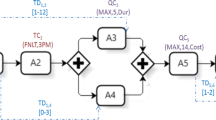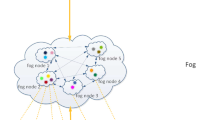Abstract
Service consumers satisfaction is considered today as one of the main concern to be ensured by service providers, especially with the spread of concurrency and the increase of functionally equivalent services. This satisfaction is closely related to quality of service (QoS) perceived by service consumers. In this context, we propose an approach to determine the satisfaction degree corresponding to the QoS of service-based applications, with regard to service consumers’ QoS expectations. Our approach is based on a preference model, which is built only on the basis of service consumer’s provided information. This preference model is also based on the 2-additive Choquet operator that takes into account preferential dependencies. In this paper, we target both design time and runtime aggregation of QoS of service-based applications.













Similar content being viewed by others
References
Canfora G, Di Penta M, Esposito R, Villani ML (2005) Qos-aware replanning of composite web services. In: Proceedings of the IEEE international conference on web services, ICWS ’05. IEEE Computer Society, Washington, DC, USA, pp 121–129
Canfora G, Di Penta M, Esposito R, Villani ML (2008) A framework for qos-aware binding and re-binding of composite web services. J Syst Softw 81:1754–1769
Cardoso J, Miller J, Sheth A, Arnold J (2002) Modeling quality of service for workflows and web service processes. J Web Semant 1:281–308
Clivillé V, Berrah L, Mauris G (2007) Quantitative expression and aggregation of performance measurements based on the macbeth multi-criteria method. In J Prod Econ 105(1):171–189
Coppolino L, Romano L, Mazzocca N, Salvi S (2007) Web services workflow reliability estimation through reliability patterns. Security and privacy in communications networks and the workshops.
Cortellessa V, Grassi V (2007) Reliability modeling and analysis of service-oriented architectures. In: Luciano B, Elisabetta Di N (eds) Test and analysis of web services. Springer Berlin, Heidelberg, pp 339–362
e Costa CB, Corte J, Vansnick J (2005) On the mathematical foundation of MACBETH. Multiple criteria decision analysis: state of the art surveys, international series in operations research& management science, vol 78. Springer, New York, pp 409–437
Fakhfakh N, Pourraz F, Verjus H (2011) Quality of service aggregation in e-business applications. In: Proceedings of ICE-B 2011 international conference on e-business. SciTePress, Sevilla, Spain, pp 100–110
Fakhfakh N, Verjus H, Pourraz F (2011) Qos aggregation in service orchestrations based on the choquet integral. In: Proceeding of the 8th IEEE international conference on e-business engineering (ICEBE 2011). Beijing, China, pp 77–84
Fakhfakh N, Verjus H, Pourraz F, Moreaux P (2011) Measuring the satisfaction degree of quality attributes requirements for services orchestrations. In: The fourth international conference on communication theory, reliability, and quality of service (CTRQ 2011). Budapest, Hungary, pp 89–94
Gallotti S, Ghezzi C, Mirandola R, Tamburrelli G (2008) Quality prediction of service compositions through probabilistic model checking. In: QoSA ’08: proceedings of the 4th international conference on quality of software-architectures. Springer, Berlin, pp 119–134
He Q, Yan J, Jin H, Yang Y (2008) Adaptation of web service composition based on workflow patterns. In: Proceedings of the 6th international conference on service-oriented computing, ICSOC ’08. Springer, Berlin, pp 22–37
Herssens C, Jureta IJ, Faulkner S (2008) Capturing and using qos relationships to improve service selection. in: Proceedings of the 20th international conference on advanced information systems engineering, CAiSE ’08. Springer, Berlin, pp 312–327
Hwang SY, Wang H, Tang J, Srivastava J (2007) A probabilistic approach to modeling and estimating the qos of web-services-based workflows. Inf Sci 177:5484–5503
Jaeger MC (2007) Optimising quality-of-service for the composition of electronic services. PhD thesis, Berlin University, Germany
Jaeger MC, Rojec Goldmann G, Muhl G (2005) Qos aggregation in web service compositions. In: EEE’05: proceedings of the 2005 IEEE international conference on e-technology, e-commerce and e-service (EEE’05). IEEE Computer Society, Washington, DC, USA, pp 181–185
Kattepur A, Sen S, Baudry B, Benveniste A, Jard C (2010) Variability modeling and qos analysis of web services orchestrations. in: Proceedings of the 2010 IEEE international conference on web services, ICWS ’10. IEEE Computer Society, Washington, DC, USA, pp 99–106
Le Blevec Y (2008) Towards the conception of extended information systems organized around a web service platform. PhD thesis, LIRIS, INSA de Lyon/Université Claude Bernard Lyon 1/Université de Lumière Lyon 2/École Centrale de Lyon
Lee K, Jeon J, Lee W, Park SW (2003) Qos for web services: requirements and possible approaches. http://www.w3c.or.kr/kr-office/TR/2003/ws-qos/
Liu Y, Ngu AH, Zeng LZ (2004) Qos computation and policing in dynamic web service selection. In: WWW Alt. ’04: proceedings of the 13th international World Wide web conference on alternate track papers& posters. ACM, New York, NY, USA, pp 66–73
Mayag B, Grabisch M, Labreuche C (2010, in Press) A characterization of the 2-additive choquet integral through cardinal information. Fuzzy Sets and Systems. Corrected proof
Menascé DA, Casalicchio E, Dubey V (2010) On optimal service selection in service oriented architectures. Perform Eval 67(8):659–675 (Special issue on software and performance)
Parasuraman A, Zeithaml VA, Berry LL (1994) Alternative scales for measuring service quality: a comparative assessment based on psychometric and diagnostic criteria. J Retail 70(3):201–230
Ran S (2003) A model for web services discovery with qos. SIGecom Exch 4(1):1–10
Rosario S, Benveniste A, Haar S, Jard C (2008) Probabilistic qos and soft contracts for transaction-based web services orchestrations. IEEE Trans Serv Comput 1:187–200
Rosenberg F (2009) Qos-aware composition of adaptive service-oriented systems. PhD thesis, Technical University Vienna, Austria
Russell N, ter Hofstede A, van der Aalst WMP, Mulyar N (2006) Workflow control-flow patterns: a revised view. Technical report, BPMcenter.org
Sato N, Trivedi KS (2007) Stochastic modeling of composite web services for closed-form analysis of their performance and reliability bottlenecks. ICSOC ’07: proceedings of the 5th international conference on service-oriented computing. Springer, Berlin, Heidelberg, pp 107–118
Serhani MA, Dssouli R, Hafid A, Sahraoui H (2005) A qos broker based architecture for efficient web services selection. IEEE Computer Society, Washington, DC, USA, pp 113–120
Szydlo T, Zielinski K (2008) Method of adaptive quality control in service oriented architectures. In: Proceedings of the 8th international conference on computational science, Part I, ICCS ’08. Springer, Berlin, pp 307–316
Taher L, Basha R, El Khatib H (2005) Qos information& computation (qos-ic) framework for qos-based discovery of web services. UPGRADE 6(4):55–66
van der Aalst W, ter Hofstede A, Kiepuszewski B, Barros A (2003) Workflow patterns. Distrib Parallel Database 14(1):5–51
Zeng L, Benatallah B, Dumas M, Kalagnanam J, Sheng QZ (2003) Quality driven web services composition. ACM, New York, NY, USA, pp 411–421
Zhong D, Qi Z (2006) A petri net based approach for reliability prediction of web services. In: OTM workshops, vol 1, pp 116–125
Acknowledgments
This work is partially funded by the FEDER MES project granted by the French Rhône-Alpes Region.
Author information
Authors and Affiliations
Corresponding author
Rights and permissions
About this article
Cite this article
Fakhfakh, N., Verjus, H., Pourraz, F. et al. QoS aggregation for service orchestrations based on workflow pattern rules and MCDM method: evaluation at design time and runtime. SOCA 7, 15–31 (2013). https://doi.org/10.1007/s11761-012-0124-0
Received:
Revised:
Accepted:
Published:
Issue Date:
DOI: https://doi.org/10.1007/s11761-012-0124-0




